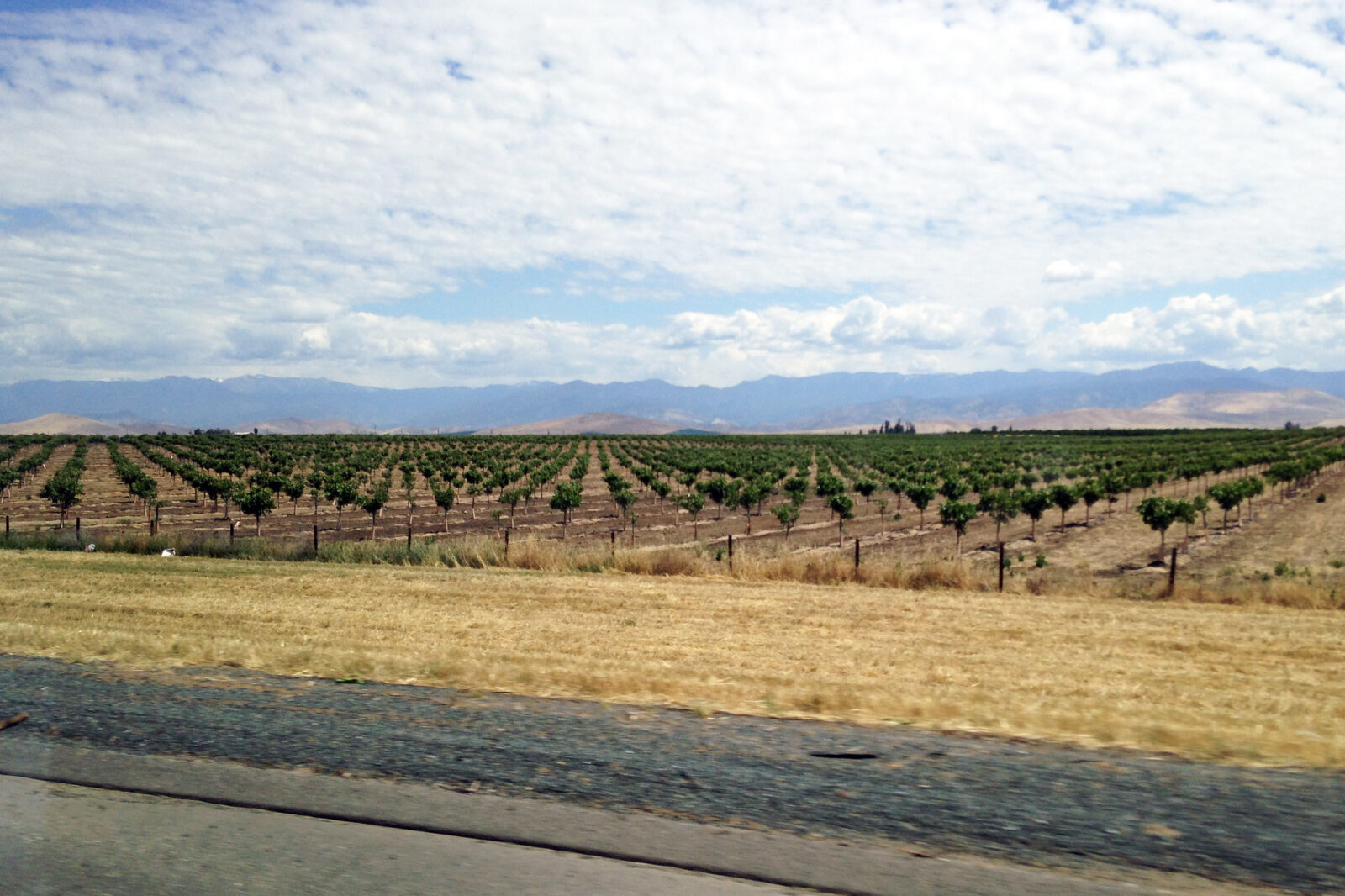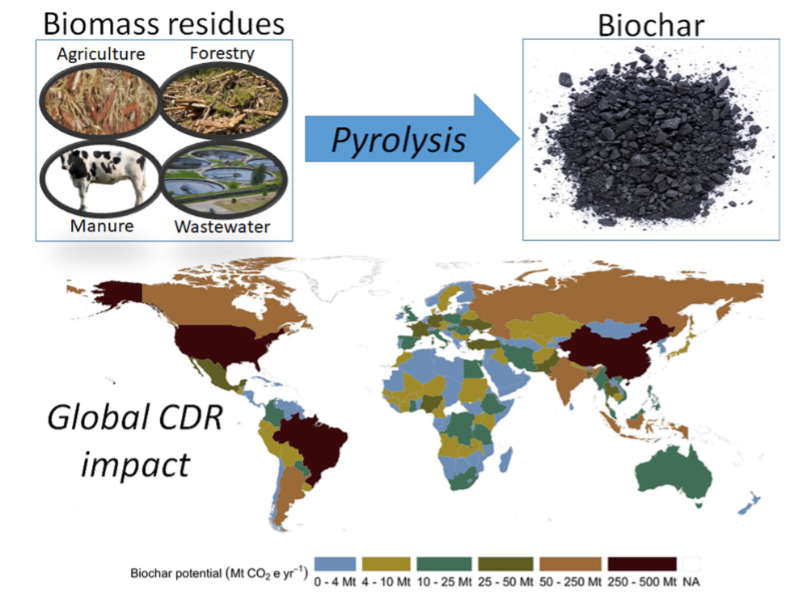Today marks the launch of a new interactive visualisation of the landscape for monitoring, reporting and verification of carbon dioxide removal methods, a joint project between the Grantham Research Institute and AlliedOffsets. Josh Burke, our Senior Visiting Fellow and Leo Mercer and Anton Root describe the purpose and benefits of the tool for policy practitioners, CDR developers and purchasers – who can use it to understand the market at a glance.
Why is monitoring, reporting and verification of CO2 removal so important?
Alongside actions to rapidly reduce greenhouse gas emissions, carbon dioxide will need to be removed from the atmosphere if the world is to meet the Paris Agreement climate goals. The Intergovernmental Panel on Climate Change (IPCC) suggests carbon dioxide removal will need to be scaled up from a current base of around 2 Gt (billion tonnes) CO₂ removed per annum to at least 10 Gt by 2030 and 100-1,000 Gt over the remainder of the century to counterbalance residual emissions.
The proliferation of net zero targets, and by extension the use – or planned use – of carbon dioxide removal (CDR) has led to increased attention on the governance of CDR. A key component of this governance architecture is monitoring, reporting and verification (MRV), which is the multi-step process to measure the amount of greenhouse gases removed by a specific removal project and reported to an accredited third party.
Robust MRV can help governments and private sector actors overcome information gaps and asymmetries that may make it difficult for them to make investment or regulatory decisions. This is critical as the current crisis of confidence in the voluntary carbon market (VCM) has the potential to erode trust and confidence in CDR, halt capital investments and slow the integration of CDR into climate policy. Successful industries rely on standards and certification to ensure activities meet expectations. The CDR industry is no different.
Furthermore, owing to the absence of internationally agreed minimum quality standards, multiple regulatory efforts (such as the EU Carbon Removals and Carbon Farming/CRCF Regulation) are developing in parallel to fast-moving technical developments in the VCM. This results in overlapping protocols for some CDR methods and incomplete MRV coverage for others. Consequently, the MRV landscape has become ever more confusing. This makes comparison and oversight of CDR difficult for investors and governments alike. Greater transparency is sorely needed.
From mapping the MRV ecosystem to launching a new interactive tool
With new protocols constantly emerging, the challenge for policymakers, researchers and investors is to maintain a systematic overview of activity and use this to improve policy. To shed light on this, as a first step in 2023 the Grantham Research Institute conducted an MRV ecosystem mapping exercise to help identify the number of, and interrelationships between, regulations, certifying entities and MRV protocols across the spectrum of CDR methods.
To qualify for inclusion, protocols had to provide guidance for CDR activities that lead to net CO2 removals from the atmosphere and carbon capture and storage (CCS). Protocols on the latter were included because CCS facilitates certain CDR methods like direct air carbon capture and storage (DACCS) and bioenergy with carbon capture and storage (BECCS).
In partnership with AlliedOffsets, we are launching today the next iteration of this work: Transparent Reporting and Certification for CDR or the TRACEcdr tool. This has digitalised our original research to create a new interactive tool for policy practitioners, CDR developers and purchasers. TRACEcdr combines the mapping efforts of the Grantham Research Institute with AlliedOffsets’ data-gathering on activity happening in the VCM.
What does the tool do?
The TRACEcdr tool responds to the challenges set out above by creating the first interactive digital tool to provide transparency and oversight to the CDR market. It involves three initial steps, two of which we can present today in the beta version.
- The first systematically maps and digitalises the MRV ecosystem for all CDR methods, providing an interactive digital MRV ecosystem.
- The second step illustrates the activity within the system by providing information on the number of projects and the volume of issued credits for each CDR method and MRV protocol. Data is provided on project registrations and issuances of credits from the AlliedOffsets database of over 32,000 projects globally, from 25 registries plus hundreds of unregistered projects.
- The third step, due for completion in 2025, will overlay the results of a systematic evaluation of MRV quality by assigning scores to the MRV protocols that underpin credit issuance.
The outcome is an interactive visualisation of the CDR MRV landscape. The tool has been created with an eye towards understanding the market at a glance, allowing policymakers and investors to grasp the complexity and activity within the ecosystem such as risks and benefits of current market activity, where activity is happening, by what methods and eventually, how rigorous and credible underlying MRV protocols are.
How to interact with TRACEcdr
Upon opening the TRACEcdr tool, four levels of the MRV system are visible:
- Level 1 is organised according to CDR method.
- Level 2 is the entity that provides the removal standard for a given CDR method.
- Level 3 details the MRV protocol and denotes whether a protocol is applicable in a national or international context and for voluntary or compliance purposes.
- Level 4 visualises credit issuance projects per protocol. The larger the node, the larger the credit issuance. Clicking on nodes in the fourth tier enables the user to isolate and trace the connected nodes in each tier below.
Users of the tool can filter for different options such as whether the protocol is nationally or internationally focussed and whether it is for use in compliance or voluntary carbon markets. CDR methods or protocols can be isolated such that all activity can be seen more easily. Some protocols do not connect to the fourth tier of the ecosystem map either because they do not have any registered projects associated with them, or because AlliedOffsets has been unable to access data on those protocols at the time of publication (this is mainly for compliance issuance due to data protection regulations).
Key insights
A major trend exemplified by the tool is the dominance of ‘land-based biological’ methods. Although methods like DACCS have dominated CDR discussion and funding, the overwhelming activity within removals today – by the sum of MRV protocols, project number and credit issuance – are projects planting trees or restoring natural carbon sinks like peatlands and soils. Indeed, of the 117 MRV protocols that have been recorded in total (between 2005 and mid-October 2024), 29% are attributable to afforestation, reforestation and forest management (A/R), 18% to soil carbon sequestration (SCS), 9% to peatland and wetland restoration and a further 5% to BECCS. In terms of credit issuance, A/R accounts for 77% of all issued credits, with peatland restoration projects constituting another 19%.
The ecosystem is currently in a rapid state of development. In 2023, 22 MRV protocols were published, which was a small increase on the total of 19 in 2022. Protocol development in 2023 skewed towards biological methods with seven protocols, and SCS with three. Data from 2024 indicate more balanced MRV development, with 15 protocols to date including two for ocean alkalinity enhancement, two for biomass carbon removal and storage (BiCRS) and two for CCS but also including single protocols for enhanced rock weathering, direct ocean capture and DACCS. 2024 may yet surpass 2023 in terms of the total number of MRV protocols published.
Although we observe a complex system with duplication and year-on-year increases in MRV protocol development, the majority of issuance is occurring through a few select protocols. For example, for peatland and coastal wetland restoration, Verra’s VM0033 protocol is responsible for 99% of issuance. For soil carbon sequestration, four protocols account for 97% of all issued credits, with Verra’s VM0032 and VM0026 respectively accounting for 31% and 30% of total issuance. For A/R, 90% of issued credits stem from just four protocols, with the California Air Resources Board’s Compliance Offset Protocol U.S. Forest Projects (compliance) issuing 64% of all credits (114 million).
This coalescence in the market has benefits and risks. On the one hand, it suggests that improvements to the dominant protocols could ripple through most of the system. On the other, it may indicate systemic risks if in the future new evidence indicates problems with these dominant protocols. For this reason, it is important that there are independent assessments of the quality and rigour of MRV underpinning CDR issuance.
Table 1. Overview of system activity
The numbers in brackets for the CDR method column indicate the total number of protocols per method, but we only illustrate the most popular
| CDR method | Registry | Protocols with greatest issuance | No. of projects | No. of issued or sold credits | % of total |
| Afforestation, reforestation, agroforestry, forest management (34) | American Carbon Registry | Compliance Offset Protocol U.S. Forest Projects | 113 | 114,065,156 | 64% |
| Improved Forest Management (IFM) on Non-Federal U.S. Forestlands | 150 | 26,243,535 | 15% | ||
| Gold Standard Impact Registry | Afforestation/ Reforestation (A/R) GHG Emissions Reduction and Sequestration Methodology | 62 | 11,389,778 | 6% | |
| Woodland Carbon Code | WCC Standard v2.2 | 2,118 | 8,955,223 | 5% | |
| Soil carbon sequestration in croplands and grasslands (21) | Verra | VM0032 Methodology for the Adoption of Sustainable Grasslands Through Adjustment of Fire and Grazing v1.0 | 11 | 6,098,086 | 31% |
| VM0026 Methodology for Sustainable Grassland Management v1.0 | 48 | 5,786,488 | 30% | ||
| Plan Vivo | PU001 Estimation of Baseline and Project GHG Removals by Carbon Pools in Plan Vivo Projects | 10 | 5,209,137 | 27% | |
| BioCarbon | BCR0001 Quantification of GHG Emission Reductions from GHG removal activities | 20 | 1,863,323 | 10% | |
| Peatland and coastal wetland restoration (10) | Verra | VM0033 Methodology for Tidal Wetland and Seagrass Restoration, v2.0 | 30 | 4,802,658 | 78% |
| Peatland Code | Peatland Code v1.2 | 295 | 1,268,675 | 21% | |
| American Carbon Registry | Restoration of California Deltaic and Coastal Wetlands 1.1 | 2 | 52,405 | 1% | |
| Verra | VM0036 Methodology for Rewetting Drained Temperate Peatlands v1.014 | 2 | 0 | 0% | |
| Biochar (5) | Puro.earth | Puro.earth Biochar Methodology Version 2.4.1 | 44 | 295,827 | 100% |
| Verra | VM0044 Methodology for Biochar Utilisation in soil and non-soil applications v4.0 | 8 | 0 | 0% | |
| DACCS (2) | Climeworks | Carbon Dioxide Removal by Direct Air Capture | 10 | 175,836 | 100% |
| BECCS (6) | Puro.earth | Geologically Stored Carbon Methodology v2.2 | 1 | 157,592 | 100% |
| Bio-oil storage (2) | Charm Industrial | Bio-oil Sequestration Prototype Protocol for Measurement, Reporting, & Verification | 1 | 154,063 | 99.997% |
| Isometric | Bio-oil Geological Storage | 1 | 5 | 0.003% | |
| Direct ocean carbon capture and storage (2) | Equatic | Methodology for Measurement, Reporting, and Verification of Electrolytic Oceanic Carbon Dioxide Removal | 4 | 63,221 | 99.2% |
| Captura | Carbon Dioxide Removal Pathway: Ocean Health and MRV | 2 | 508 | 0.8% | |
| Biomass sinking (1) | Running Tide | Framework Protocol for Multipathway Biological And Chemical Carbon Removal in the Ocean | 2 | 18,398 | 100% |
| Enhanced rock weathering (5) | Puro.earth | Enhanced Rock Weathering in Soil Methodology | 1 | 12,276 | 100% |
| Carbfix | Permanent and Secure Geological Storage of CO2 By In-Situ Carbon Mineralization | 8 | 0 | 0% | |
| Ocean alkalinity enhancement (4) | Planetary | Ocean Alkalinity Enhancement MRV Protocol | 0 | 8,684 | 97% |
| Ebb Carbon | Measurement, Reporting and Verification for Safe and Effective Carbon Dioxide Removal | 1 | 256 | 3% | |
| BiCRS (2) | Isometric | Biomass Geological Storage | 1 | 4,403 | 100% |
| Geological storage (1) | Puro.earth | Geologically Stored Carbon Methodology v2.2 | 1 | 587 | 100% |
| Mineral products (2) | Gold Standard Impact Registry | Carbon Sequestration Through Accelerated Carbonation of Concrete Aggregate | 15 | 149 | 100% |
| Marine biomass sinking (1) | Rewind | Marine Terrestrial Biomass Storage | 3 | 0 | 0% |
| CO2 capture, transport and storage (9) | Australian Carbon Credit Units | Carbon Credits (Carbon Farming Initiative—Carbon Capture and Storage) Methodology Determination 2021 | 1 | 0 | 0% |
One more surprising insight, given that MRV development for CDR methods is primarily happening in the VCM, is the major role of compliance markets. Just under 60% of credits issued can be used in compliance markets, most significantly within California’s Air Resources Board programme. However, outside of California and in terms of novel durable CDR, there is no virtually issuance in compliance markets yet.
Note that the data are derived only from those projects that are registered on a registry adhering to a protocol included in our analysis. Many novel companies and projects are in the pilot phase, meaning they are not adhering to any protocol when selling credits. This carries risk for buyers, but it also allows the suppliers to launch and sell credits quickly, without needing to develop a protocol and certify against it, a process that can take years. We can expect this to continue over the next decade, as pilot projects begin to issue credits and more projects come online.
Future plans for TRACEcdr
The release of the beta version of the TRACEcdr tool today is an early step in promoting openness and transparency in CDR markets. We are using this release to product-test and gain insights and feedback from user experience. The data will be updated on a regular basis. Further iterations will include more visualisations, and more data added for each of the protocols and a second release in the second quarter of 2025.
Access the TRACEcdr tool at https://www.lse.ac.uk/granthaminstitute/tracecdr/. We welcome user feedback – please send to l.w.mercer@lse.ac.uk / j.burke2@lse.ac.uk.
Josh Burke is a Senior Visiting Fellow at the Institute for Responsible Carbon Removal and a Senior Policy Fellow at the Grantham Research Institute; Leo Mercer is a Policy Analyst at the Grantham Research Institute; Anton Root is the Co-Founder of AlliedOffsets. The opinions expressed in this writing are the authors’ own and do not reflect the position of any employer.

















